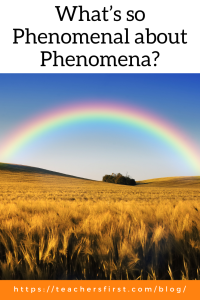“A Scientist in his laboratory is not a mere technician; he is also a child confronting natural phenomena that impress him as though they were fairy tales.”
– Marie Curie
The introduction of the NGSS Science Standards placed an emphasis on the use of phenomena in the classroom. But what exactly is a phenomenon, and why is it so phenomenal for learning?
Simply put, a phenomenon is something that happens or exists in the natural world. It can be anything from a simple observation to a complex natural system. Phenomena are often puzzling and intriguing events that spark curiosity and begin the inquiry process. While older teaching methods introduce topics using abstract ideas and definitions, phenomena-based instruction begins by introducing the phenomenon and providing students the time to observe, ask questions, and develop experiments.
For example, if your students were studying life cycles of plants and animals, you could present time-lapse videos of a plant, tadpole, or butterfly to allow students to wonder, observe, infer, and utilize science skills. Ultimately, the phenomena guides them to investigations and immerses them in the act of doing science instead of passively learning.
How Phenomena Transform Teaching and Learning
The use of phenomena can transform teaching and learning in several beneficial ways. Primarily, student engagement will increase because the content is more relevant to their lives. Students become more involved in the learning process and must develop investigations to find answers, solve problems, or learn more about the phenomenon. In addition, the integration of phenomena encourages students to think critically about the world around them. Students begin to see connections across the natural world and understand science as a series of systems and connections.
Phenomena-based instruction promotes student centered-lessons that increase collaboration among peers. Students work together to investigate phenomena and can ultimately learn from each other, modeling the social and collaborative aspects of the science world that students often misunderstand. Once they start to approach science as a collaborative learning process, the phenomenon starts to become more relatable and meaningful.
Why Phenomena Are Important for the Modern Classroom
Phenomena harnesses the power of a student’s natural curiosity. When a student observes a phenomenon in the real world, they are often motivated to ask questions, investigate, and develop experiments. In today’s classroom, it is more important than ever to teach students to think critically, solve problems, collaborate, and innovate. Infusing phenomena into instruction can help develop and foster these skills at a younger age.
Examples of Phenomena in the Classroom
Here are a few examples of how you can integrate phenomena in your classroom:
- Launch a lesson – Having tudents observe phenomena at the beginning of a unit enables them to take ownership and direction of their learning. They can determine what to investigate and develop an interest in the content. Find inspiration for starting with phenomena by exploring The Wonder of Science (reviewed here).
- Research tool – Students can investigate a phenomenon related to a specific topic by researching the causes and effects, exploring ways to create models, and supporting the learning of other students in the class by presenting what they learned. Students can use presentation tools like Presentious (reviewed here) to communicate their findings.
- Assessment – Completing an authentic assessment allows students to apply and transfer their knowledge and utilize what they learned in class to a real-world application. Teachers can use MagicSchool (reviewed here) to help generate assessment ideas based on phenomena.
If you’re looking for ways to make your science lessons more engaging and effective, try using phenomena. You may be surprised at the shift in your classroom!


